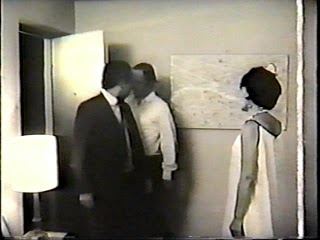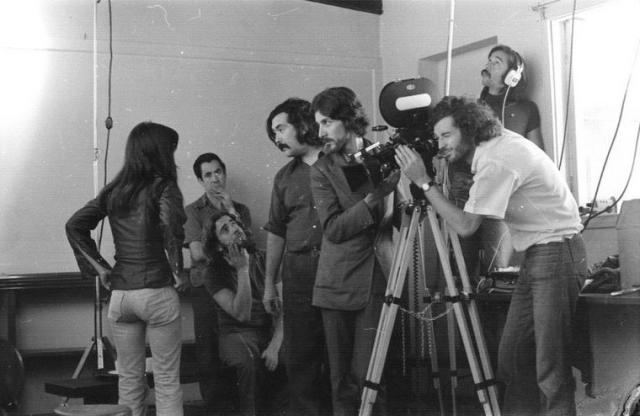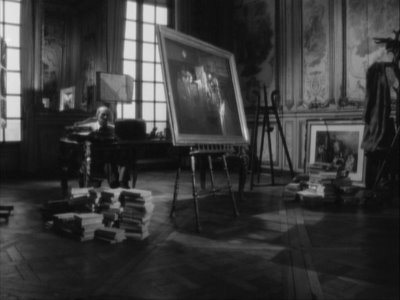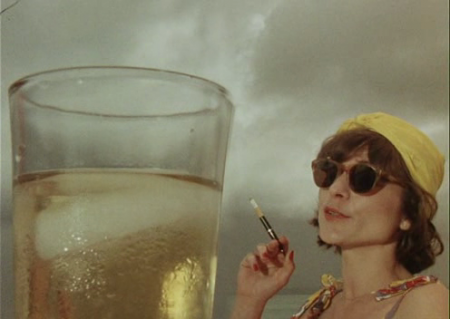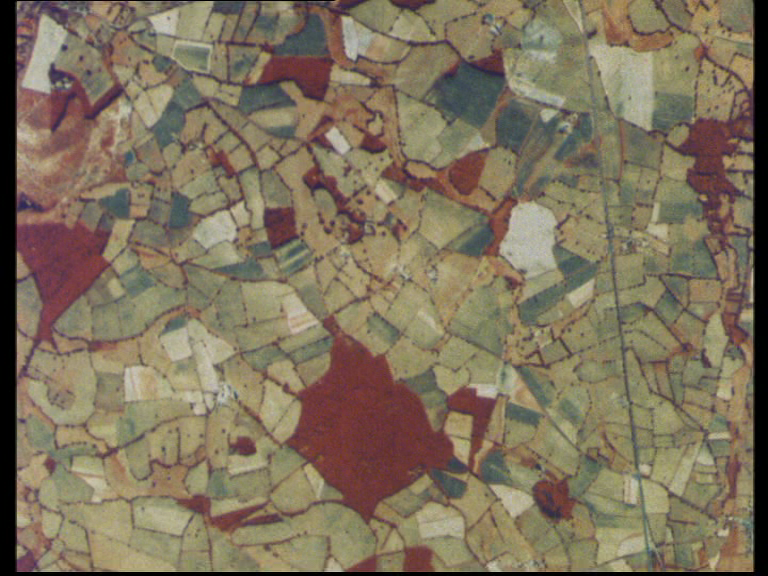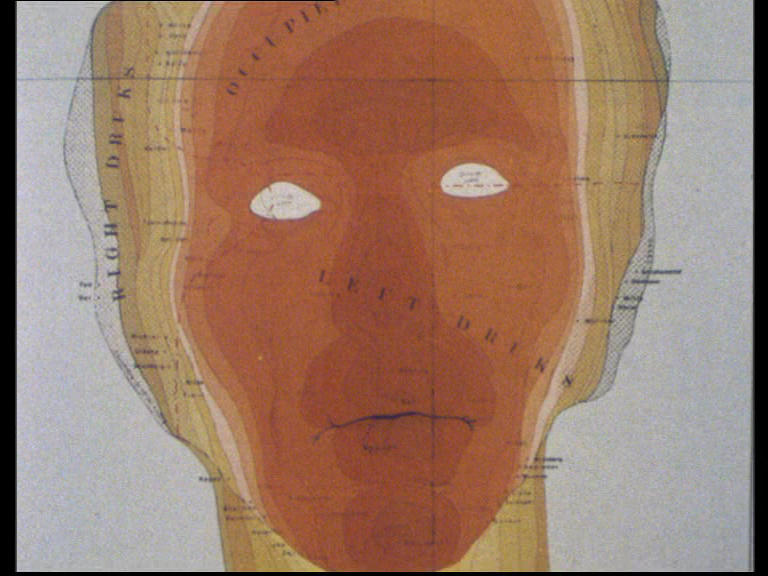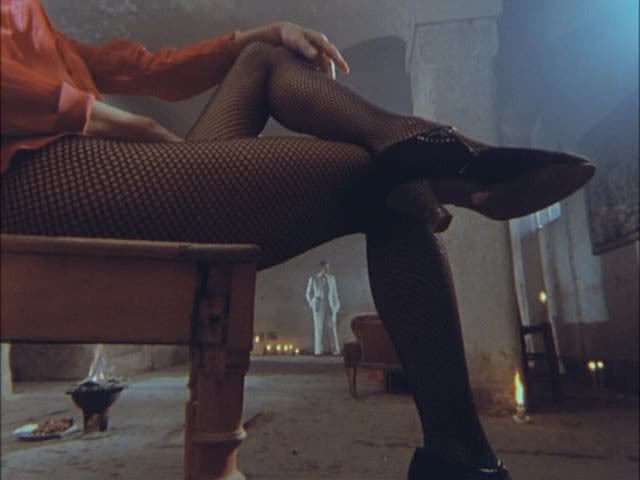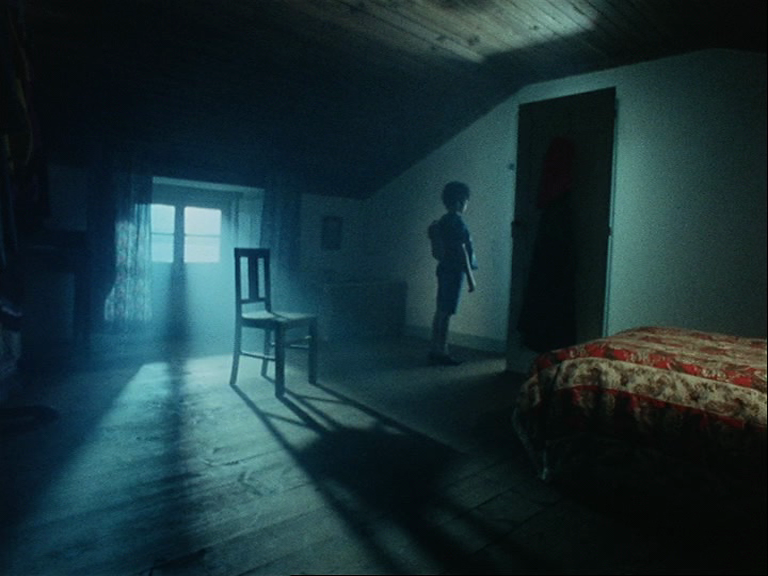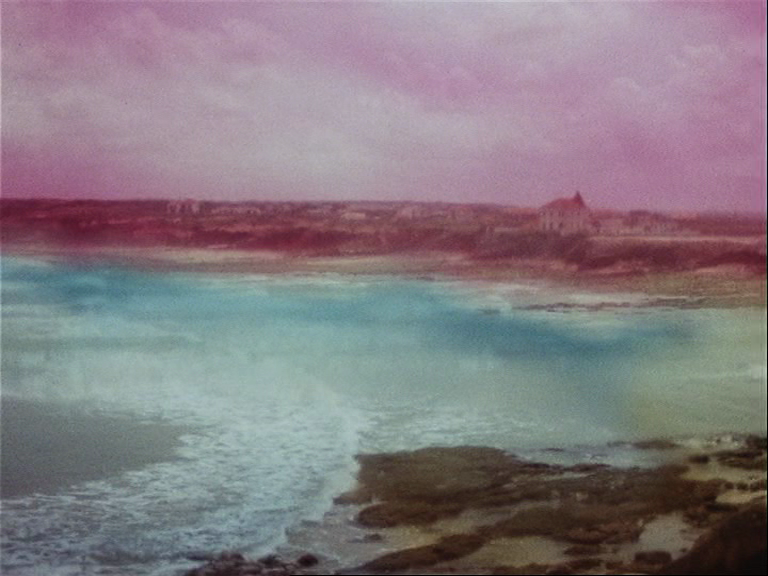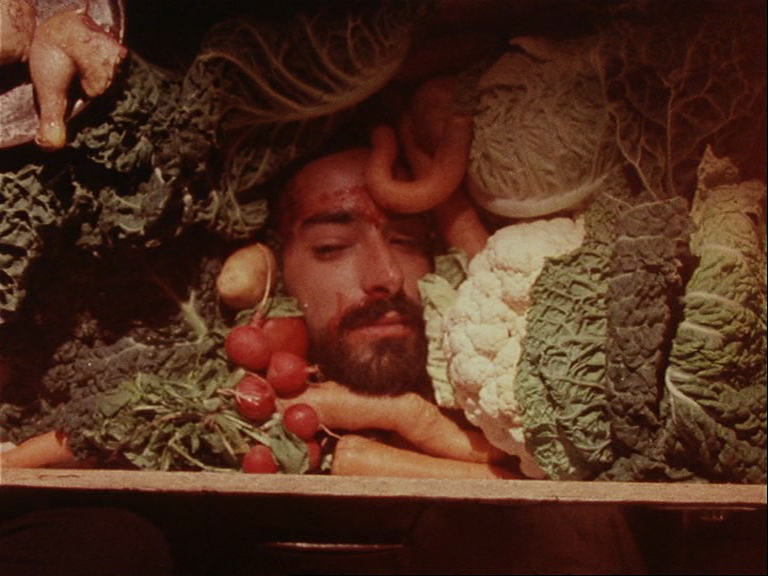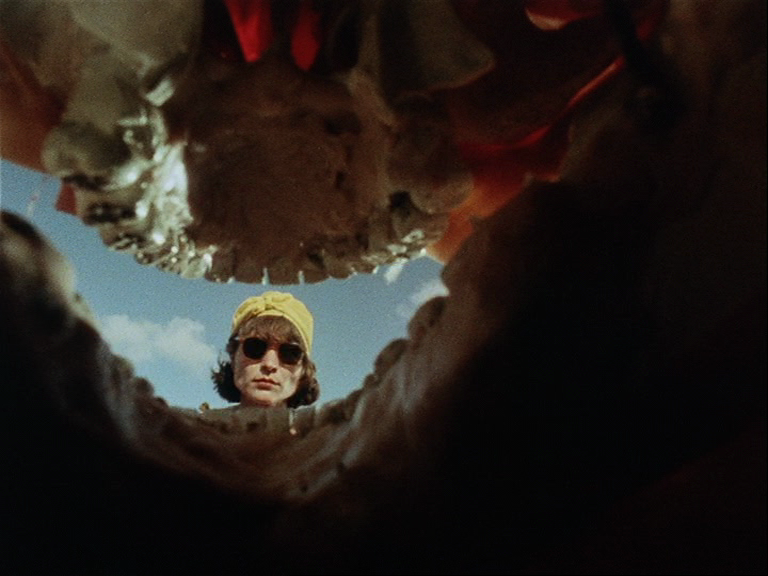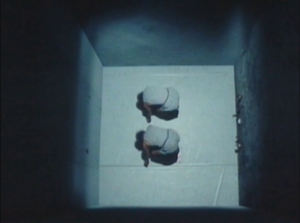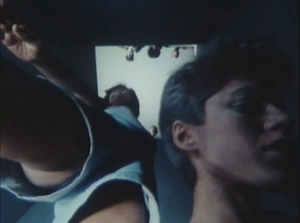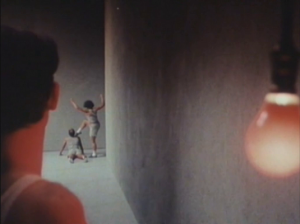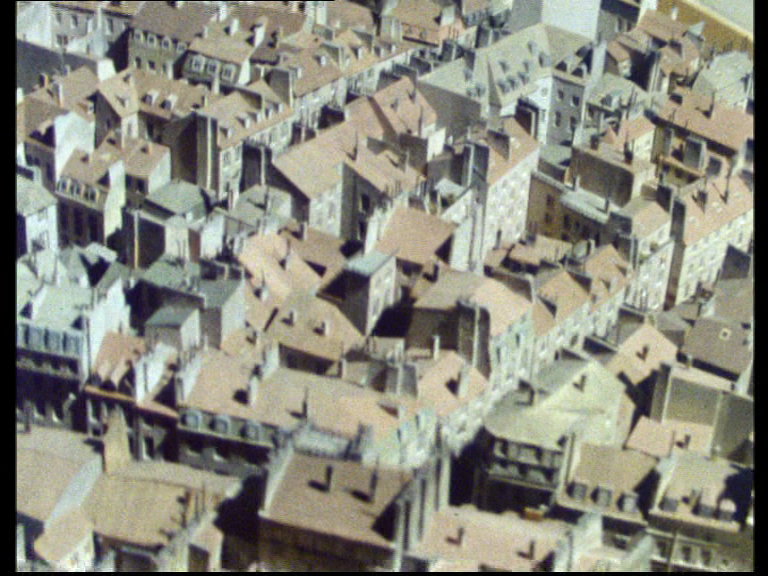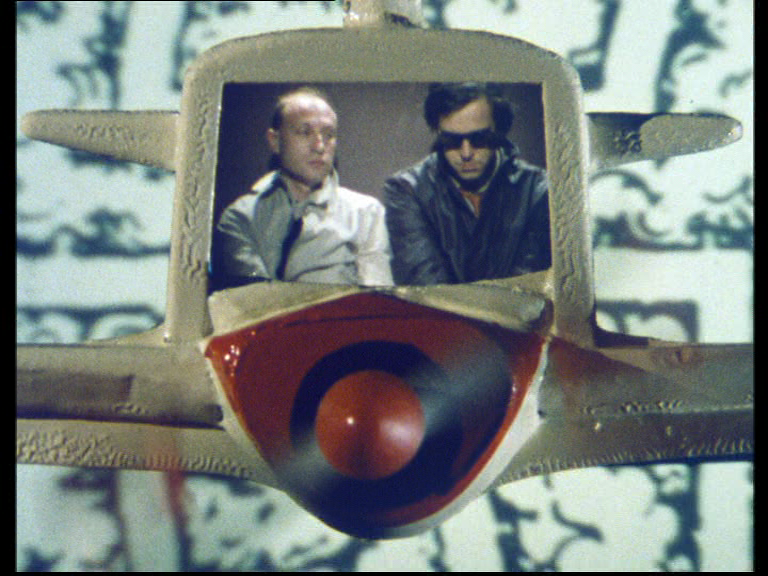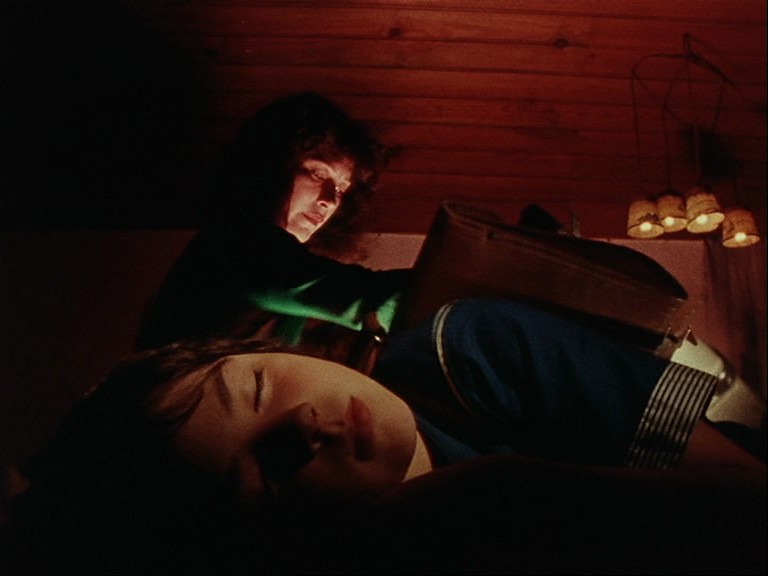Even though much of this early piece of mine about Ruiz (also available in my collection Placing Movies), originally published in separate versions in 1987 and 1990, is out of date by now, and also incorrect in spots, I’ve decided to reprint and illustrate it here, over three decades later, because of the way Ruiz inspired me to play various games of my own, as he did several years later when I wrote about him at some length again (here). (August 2011, shortly after Ruiz’s tragic death, I’ve also updated the illustrations for my 2002 interview with him for Cinema Scope.) — J.R.
Preface
The sheer otherness of Râúl Ruiz in a North American context has a lot to do with the peculiarities of funding in European state-operated television that make different kinds of work possible. The eccentric filmmaker in the United States or Canada who wants to make marginal films usually has to adopt the badge or shield of a school or genre — art film, avant-garde film, punk film, feminist film, documentary, or academic theory film— in order to get funding at one end, distribution, promotion, and criticism at the other. Ruiz, however, needs only to accept the institutional framework of state television — which offers, as he puts it, holes to be filled — and he automatically acquires a commission and an audience without having to settle on any binding affiliation or label beyond the open-ended rubric of “culture” or “education.” Consequently, the sheer existence of Ruiz’s massive, varied work constitutes a genuine affront to the capitalist definitions of experiment governing our own culture. An obsessive tinkering into possibilities that successfully evades most of the ghetto classifications we assign to marginal works, the Ruiz oeuvre strikes us as “too much” or “too little” precisely because we can’t comfortably file it away — even if it arguably constructs on occasion a new European ghetto of its own.
For all their differences every Ruiz film or tape seems to combine some aspect of the laboratory and the playpen, usually redefining what we mean by “serious” and “unserious” in the process. Half bricoleur , half enfant terrible, Ruiz recalls the exemplary careers of Godard and Warhol, not only through the sheer size of his output but also through the unsettling combination of professionalism and amateurishness. Next to Godard’s you-can-put-anything-in-a-film and Warhol’s anyone-is-an-actor credos — to which one might add Jacques Rivette’s dissolution of the distinction between good and bad acting by positing that everything an actor does is interesting — Ruiz’s strategy of subverting his adopted formats from within creates a parallel form of mock seriousness where almost anything can be said or done with relative impunity. By shifting the rules of the game, all four filmmakers have outlined a new route toward freedom and productivity.
To understand how Ruiz has arrived at such a position, one must first consider where he comes from. A Chilean born in 1941 in Puerto Montt who studied theology and law (perhaps the two subjects most governed by institutions), he significantly made his first serious foray into the arts via institutional funding — a Rockefeller grant that allowed him to write over a hundred plays between 1956 and 1962. A good many years later, many of these plays would form the basis of several of his screenplays. After writing a couple of unrealized film scripts, he attended film school in Santa Fé, Argentina, for a year, eventually rebelling against the dogma “that it was the duty of every human being in Latin America to make documentary films” by quitting in 1967 to embark on an ambitious feature in Buenos Aires, loosely inspired by a Daphne du Maurier novel, which was never finished. (Like many of Ruiz’s Chilean works, it is a lost work in more ways than one; the whereabouts of the only print are currently unknown.)
Then Ruiz wrote and directed TRES TRISTES TIGRES (1968), adapted from a play by Alejandro Sieveking — a film with no relation to G. Cabrera Infante’s epic Cuban novel of the same title — and won the Locarno Film Festival’s grand prix with it in 1969, although it was seen by only thirty thousand or so spectators in Chile. Judging from various interviews, the film has a neorealist subject — the marginal Chilean lower and middle class, according to one interviewer — but a somewhat self-reflexive style influenced by the nouvelle vague which played on camera/actor relationships: a 28-millimeter lens was used exclusively, the actors’ awareness of the (mainly handheld) camera was emphasized rather than discouraged, and Ruiz notes “an attempt to tackle the embarrassment of Mexican melodrama by a kind of inversion, as if the camera were in the opposite position, showing the secondary characters, extras waiting for the big scene to take place.” (See the interview with Ian Christie and Malcolm Coad in Afterimage, no. 10, Autumn 1981.) (1)
Next came an abortive collaboration on a Chilean/American coproduction (QUE HACER? , 1970) which Ruiz now dismisses, and a 16-millimeter feature suggested by Franz Kafka’s “In the Penal Colony” (LA COLONIA PENAL, 1971), which is somewhat more substantial, although it survives only in a truncated version. (Dealing with an island whose main industry is the manufacturing of news and whose language is “completely invented,” the film anticipates the metaphysical conceits of such later films as LA TOIT DE LA BALEINE .) This was followed by Ruiz’s first television commission, NADIE DIJO NADA (1971) — a free adaptation of a Max Beerbohm story for Italy’s RAI which he managed to complete under budget, thus enabling him to make his next two features: the hour-long L’EXPROPIACION (1972) and the nearly four-hour EL REALISMO SOCIALISTA (1973). Over the same two years, Ruiz made three shorts for Chilean television, a feature based on a best seller (Palomita Blanca , “a kind of Love Story . . . read by one million people, which is 10 percent of the Chilean population”) which was subsequently cut and banned for export, an hour-long documentary about the numerous young girls auditioning for the lead part in PALOMITA BLANCA, and an additional short. Then came the military coup of September 1973, and with it Ruiz’s exile: he moved to Paris in February 1974.
Since then, be has gradually come into his own and into international prominence as a writer-director in almost continual production thanks to state television commissions in France, Germany, Holland, and Portugal — and, more recently, his job as codirector of the Maison de la Culture of Le Havre with Jean-Luc Fargier, which allows him in effect to coproduce his own films and produce films by other filmmakers —yielding a flurry of activity that has particularly increased in the 1980s, and now includes directing theater, building films around other cultural events (e.g., the visit of Jean-Claude Gallotta’s dance group to Le Havre in MAMMAME ), and producing such films as Manoel de Oliveira’s MON CAS. His first prestigious European film, L’HYPOTHÈSE D’UN TABLEAU VOLÉ (1978) — unless one counts the more difficult and esoteric LA VOCATION SUSPENDUE , made the previous year, which won the first prize at the 1978 San Remo Film Festival—helped to establish the Borgesian side of his reputation by positing a playful metaphysical system as the basis of his fantasy and suggesting a subtle camp irony lurking behind the taste for academic pedagogy, fanciful English storytellers (from Coleridge to Carroll to Stevenson to Chesterton), and notions of narrative as impenetrable labyrinth.
This literary aspect of Ruiz would seem to place him within hailing distance of the European art film, but the camp mockery of the latter’s forms of seriousness, consistency, and craft invariably prevent this snug identification from taking hold. (The affinity noted by many critics with low-budget Welles films such as MR. ARKADIN and THE IMMORTAL STORY may come closer to the mark, at least regarding transgressive camera angles, compulsive globetrotting, flashbacks and other fabulist forms of address, and “irresponsible” production values.) To greater or lesser extents, all Ruiz works are closet comedies bent on undercutting whatever forms of solemnity threaten to congeal discourse into predictable patterns of illusion-making, ideology, editorializing, and/or generic complacency. But apart from certain shorts like COLLOQUE DE CHIENS and QUERELLE DE JARDINS, none of them is an overt comedy either, so that the relative security of that genre is no less remote.
It’s partially the strategy of this political exile to elude categorical imperatives; to be categorized, after all, is the first step toward being labeled an undesirable. From this standpoint, the flippant whimsy of Ruiz is comparable to the irony of Nabokov, which holds many of his meanings perpetually in check. With everything theoretically open to contradiction and assault, most generalizations about Ruiz — probably this one included — have to be approached with some caution and skepticism. Writing from the vantage point of an American over five thousand miles from Paris who has managed to glimpse little more than a tip of the iceberg, mainly during short visits abroad — twenty-five features and seven shorts (2), all but three of them non-Chilean and post-1973, seven of which (COLLOQUE DE CHIENS, LA TOIT DE LA BALEINE, LES TROIS COURONNES DU MATELOT, DES GRANDS ÉVÉNEMENTS ET DES GENS ORDINAIRES, LA VILLE DES PIRATES, MÉMOIRE DES APPARENCES , and MAMMAME ) I’ve managed to see more than once — I hope that the notes that follow are at least true to the hypothetical filmmaker I’ve constructed.
***
According to the mathematician Pierre Rosenstiel, the “wise Ariadne” method consists of backtracking after exploring each new corridor. That way, it is known, and then it is the turn of another. By contrast, crazy Ariadne explores as much as possible and only backtracks as a last resort. These two attitudes are coherent and make it possible to resolve the labyrinth. Every traveler may be considered myopic. He cannot see further than the horizon. The map is the means of enlarging one’s field of vision. Thus the map of the maze destroys the maze at a stroke. The map suppresses the labyrinth. The history of cartography is therefore the business of labyrinth destruction, as was known five thousand years ago. A labyrinth is resolved — one also says “beaten” — when each corridor has been used once and only once in each direction.
From one point of view, at least, any attempt to chart the breadth and unity of Ruiz’s works in film and video threatens to become a betrayal of that work. If the map suppresses the labyrinth, it is always possible that the cultish desire to possess Ruiz’s oeuvre as a coherent entity works against many of Ruiz’s own strategies. An anti-auteurist par excellence, Ruiz proceeds partially by subterfuge and anonymity, addressing many of his works to an audience whose responsiveness is largely predicated on not knowing who he is or even precisely what he is up to. To a certain degree, Douglas Sirk operated on such a principle in Hollywood during the 1950s, making the social and aesthetic experiences of his films of that period qualitatively and quantitatively different from the experiences they have afforded Sirk critics in the 1970s and 1980s — few of whom have acknowledged or dealt with this striking discrepancy.
Take for instance the contemporary French television audience that the two-part, 100-minute PETIT MANUEL D’HISTOIRE DE FRANCE was designed for, who saw it transmitted in the series Rue des archives on successive weeks in late September 1979. A videotape compilation of French history “from our ancestors the Gauls . . . to the invention of cinema,” it proceeds exclusively through quotation, comprising an audio-visual equivalent to the sort of work Walter Benjamin once dreamed of producing. Clips from former French television programs and series depicting French history are accompanied by the voices of French schoolchildren reading from primary school textbooks that date from 1903, 1929, 1956, and 1968. Frankly fictionalized depictions of events derived from plays are interspersed with more nonfictional “recreations,” and some of the juxtapositions are spatial as well as temporal, for the programs make frequent use of split-screen diptychs. To keep the chronology straight and the format educational, the date of a given event often appears in the upper right comer of the frame; and in keeping with the French auteurist consciousness that tends to see each representation as an individual creation, subtitles periodically identify each clip with a title and one or more auteurs.
The subversive aspect of SHORT HISTORY OF FRANCE mainly has to do with the overall proliferation of representations, whereby the same actor might turn up portraying two or more characters in periods that are centuries apart, and Joan of Arc is successively presented to us via Shaw (Saint Joan), Meunier (Jeanne et ses Juges), and Claudel (Jeanne au Bûcher). This leads to a subtle tone of self-parody, amplified in part by the faltering or mechanical deliveries of some of the off-screen children, which gradually undermines the very notion of history which the series is presumably designed to perpetuate — a sly sense of derision that only comes to the fore when Ruiz finally gets to Napoleon and uses what is apparently the series’ only film clip, a frenetic rapid montage from Gance’s NAPOLÉON. To hammer his point home, Ruiz immediately follows this clip with an equally rapid montage of his own, running through earlier parts of the program — a helter-skelter slag heap of near-subliminal flashes, one shot per era, which effectively reduces all of French history to a hysterical flood of incoherent clichés. Then the program calmly reverts to business as usual, and the reductio ad absurdum principle remains as an implicit echo rather than as an explicit strategy. Having made his momentary assault, Ruiz fades back into the woodwork, resumes his anonymity, and indeed the only overt sign of the program’s double edge to come at the end appears to be entirely fortuitous, when the following legend appears on the screen: “La prochaine semaine: La vie est un spectacle.” (“Next week: Life is a spectacle.“)
But SHORT HISTORY OF FRANCE represents only one side of the Ruizian dialectic. No less characteristic are two fiction features shot on the same Portuguese island in 1983, LA VILLE DES PIRATES and POINT DE FUITE. If SHORT HISTORY OF FRANCE is essentially defined by its institutional and educational framework, these two films are characterized no less strikingly by their virtual lack of classification, genre, or motivation apart from pure stylistic play. The first two Ruiz features that I happened to see, they are oddly alike in their steadfast refusal to cater to the ostensible consumer demands of arthouse patrons. They are irresponsible works in the fullest sense of that term — not merely in their dogged marginality, but also in their refusal to aspire to the rigor or consistency of masterpieces, their total unwillingness to marshal their forces in any single, concerted direction. Indirectly yet decisively, they ridicule the activity of artmaking itself.
First hypothesis: it’s an old map and perhaps the city has changed. The map lags behind the territory. It is partly inaccurate.
Second hypothesis: the map is prospective. It serves as a model for development. It is in advance of the territory. The city does not yet resemble the map.
Third hypothesis: the city has been destroyed by a cataclysm and has been rebuilt in accordance with several maps. These present the characteristics described in the first two hypotheses. The inaccuracies are compounded. So one must envisage the construction of a perfect map.
First proposition: the perfect map would be on the scale of one to one. It would be as big as the territory. Direction signs and road nameplates can be seen as a timid endeavor to create this perfect map, which would make it possible to do without a map.
Second proposition: the perfect map would be the sum of all possible mutes, memorized on a videodisc, which would reproduce them as required in a visual form. This perfect map would render inestimable services to the army, tourist agencies, and all sorts of travelers.
My own credentials for mapping Ruiz, as suggested earlier, are limited by the fact that the only Chilean features I’ve seen to which his name is connected are the 1970 QUE HACER?, made jointly with Saul Landau, James Becket, Nina Serrano, and Billy Yahraus, which he currently disowns, and THE PENAL COLONY, which is no longer complete. Judging from most accounts of his early films, they seem to be interesting but “pre-Ruizian” to the degree that they are Chilean or Latin American in subject, hence regional — if we understand that “Ruiz” in this context is less a biological entity than a particular point of convergence between different levels of culture, and a lack of fixed identity or allegiances which make work as mercurial as the PETIT MANUEL, LA VILLE DES PIRATES , and POINT DE FUITE possible. This is essentially the condition of the exile which Ruiz has shared since 1974, and the subject of the first film he shot after leaving Chile as a political refugee:DIÁLOGO DE EXIL IADOS (DIALOGUE OF EXILES, 1974), made in Paris. Rightly or wrongly, it is here that the Ruiz I am mainly discussing is born.
Starting with a quote from Brecht which asserts that immigrants make the best dialecticians, DIALOGUE OF EXILES proceeds in a manner that is sufficiently dialectical to estrange many Chilean and non-Chilean viewers alike.
As Ruiz pointed out in a 1975 interview, this approach led to certain political misunderstandings as well as to a diffused narrative which presented other difficulties. But it also created certain analytical possibilities:
It is a film with a story: a group of exiles takes a hostage to prevent him from singing. Around this I developed a narrative which works against the usual pyramid of direction in normal commercial cinema, with its main protagonist and secondary characters. Here different characters are to the fore at different times and the raise en scène works to eliminate the pyramid, as I play on the contrast between rigorous direction and the natural informality of dialogue and acting. The union of these rather contradictory elements creates a certain potential, a capacity for analysis.
With an ambience suggesting PARIS NOUS APPARTIENT and early Robert Kramer (people seated around tables in small flats), and a dramatic rhythm structured around arrivals and departures (with doors and windows central pivots in the raise en scène), this feature manages to dissipate much of the tension generated by its central premise (a fascist emigré Chilean singer who increasingly irritates the Chileans helping him out) through its shifting narrative focus. This yields an interesting ambiguity of approach — making it, as Ruiz points out, a political film which eschews both propaganda and spectacle—but a less than compelling plot. (Among the cast are Argentinian emigré director Edgardo Cozarinsky and Valeria Sarmiento, Ruiz’s wife and editor on most of his films since the early 1970s — and, starting with NOTRE MARIAGE in 1984, a director in her own right.) At the same time, the film remains fluid enough to contain a dream sequence set in Santiago—albeit one confined to a single blue-tinted shot. What seems most apparent is the trait already discussed in reference to the subsequent LA VILLE DES PIRATES and POINT DE FUITE : a refusal to cater to any particular audience, marginal or mainstream — or, put differently, a willingness to explore certain areas without any apparent compulsion to be commercially packageable.

On this scale, two maps start to diverge. The map about to disappear is called the mental map. It is the image of a known territory. It is made up of habits, memories, feelings. It is the familiar universe of spaces commonly frequented. The other is a paper map, which represents a little-known or unknown territory. Scientists claim that we only see what we know. We must therefore conclude that the paper map is all-powerful.
A critical quandary: If Ruiz isn’t an auteur, how does one deal with the obsessive repetition of certain themes in otherwise disparate works? The idea of a corpse hacked up into several pieces which are then hidden in separate places figures in at least three works made over a six-year period. In UTOPIA (aka MENSCH VERSTREUT UND WELT VERKEHBT), a ZDF (German television) commission that was itself dismembered by one-third to its present length of one hour, it provides the central plot premise; two years later, it recurs as an important incident in the parodic/melodramatic short COLLOQUE DE CHIENS; and in 1981, it figures as a passing detail in the dialogue of one of the initial episodes of LE BORGNE, an independently made metaphysical serial — shot privately over weekends by Ruiz with the assistance of friends and television technicians — which is apparently still unfinished.
A possible solution to this quandary: metaphorically speaking, the corpse in question may be Ruiz’s own status and identity as an auteur, which commercial, political, national, and institutional categories have torn asunder and buried in diverse locations — making Ruiz critics a bit like police inspectors. In UTOPIA , also known as THE SCATTERED BODY AND THE WORLD UPSIDE DOWN , two traveling salesmen in Honduras are looking for pieces of the body of a lost friend and, according to Ruiz, each piece suggests “an isolated aspect of utopia.” Is auteurism for Ruiz an unattainable utopian ideal, given the diversity of his projects and commissions, or an idealist illusion to be shunned? The work as a whole poses this dilemma without conclusively resolving it.
“For Ruiz,” writes David Ehrenstein in Film: The Front Line 1984 (Arden Press, 1984), “film is a form of anti-religion — a free zone capable of producing perpetual disbelief.” Perhaps part of the reason for this position is the mercurial nature of his production, which often turns expediency into an aesthetic and/or metaphysical position. To cite one extreme instance of this, POINT DE FUITE (VANISHING POINT ) arose in part out of a dare that Ruiz surpass Fassbinder’s record of shooting seventy-odd camera setups nonstop; without bothering about retakes, Ruiz inched that record well into the eighties. Shot with damaged stock and wearing its shoddiness like a crown, the film oscillates (like LA TOIT DE LA BALEINE ) between half a dozen languages, mainly atonal English and monotonal French, and drives one slightly batty with its portentous central gambling metaphor (poker games between three variously bandaged men), its seemingly irrelevant jazz drums on the sound track, and the capacity of each line reading to make the petulant dialogue (someone’s ex-wife left the United States “because she couldn’t stand the chicken there”) sound even less likely than it reads. But the frustrated spectator who insists on locating some apparent raison d’être for the project may ultimately have to settle for the rather gratuitous dare cited above. The perverse fascination of this impulse — cinema for the sheer hell of it — is that, unlike most other forms of “bad” filmmaking valorized by the all-devouring cinematic apparatus, VANISHING POINT cannot be absorbed or justified — that is, consumed — according to any principles of transcendence (unless, perhaps, one postulates it as a very esoteric form of camp). Consequently, it is somewhat misleading — if initially provocative — to describe Ruiz as “the Edgar G. Ulmer of the art film,” as various critics have done. For one thing, the fact that VANISHING POINT exists only as an unprocessed workprint — and is not likely to become anything else in the foreseeable future — only emphasizes the degree to which it is commercially unexploitable in a way that no Ulmer film ever is, at least to my knowledge. (3)
To cite Ehrenstein again, “By working cheaply, quickly, and quasi-anonymously on projects that are by and large made to order, Ruiz puts himself in the position (from a production point of view) of an Edgar G. Ulmer. In point of fact, if ‘art’ cinema has taken the place once occupied by the ‘B’ film, then Ruiz is certainly Ulmer’s heir.” One must bear in mind, however, that the conditions that periodically allowed Ulmer to prosper in B-films probably exist now only in European television, where there are “holes to be filled” as there once were in the second-feature category. As an “art” film director, however, Ruiz seems to occupy a position that is a good deal more precarious, despite his prolific output. The only “art” feature of his to have had a relatively wide international exposure, LES TROIS COURONNES DU MATELOT (1983) (4), has not fared very well outside of Paris — largely, one feels, because its cocky eclecticism is difficult to absorb without any understanding of Ruiz as a multifaceted phenomenon (and one whom, like Godard in the 1960s, is undoubtedly more interesting for his work as a whole than for any single “masterpiece”). To my mind, despite the film’s dazzling employment of wide-angle, deep-focus color photography (intermittently suggesting a comic book version of Welles) and many arresting and disturbing surrealist conceits, THE THREE CROWNS OF THE SAILOR has a certain formalistic dryness that may have made it a less than ideal introduction to Ruiz’s work for viewers on this side of the Atlantic. At least this was apparently the case for the North American audiences who encountered it, mainly at festivals, in 1984 — and whose mainly hostile responses, combined with the hostility or indifference of all but a few North American film critics, make the possibility of a Ruiz market on this continent extremely unlikely, at least in the immediate future. (Another liability may have been a certain acerbic macho/misogynous undertone tied to the film’s sailor milieu, along with an antirealistic geographical vagueness that equally links the film to Fassbinder’s QUERELLE — a film that gave North American critics an equal amount of trouble.)
The problem is, it is difficult to come up with any single Ruiz feature that can be cited as a potential Open Sesame that might turn him into a marketable commodity. My own five favorites at the moment — LA TOIT DE LA BALEINE (1981), LA VILLE DES PIRATES (1983), MANUEL À L’ÎLE DES MERVEILLES (1984), MAMMAME (1985), and MÉMOIRE DES APPARENCES (1986) — all have a richly textured density that recommends them as intellectual fantasies and sensual treats, but none of them can boast a narrative line that sustains interest on its own terms throughout.
To take them up briefly in turn: THE ROOF OF THE WHALE , the one with the most pronounced ideological/ political/polemical thrust, deals brilliantly with the plight of an anthropologist trying to learn the language of an obscure Patagonian Indian tribe whose last surviving members he has discovered. Beautifully and inventively shot in color by Henri Alekan, the film proceeds less as narrative or as drama than as a prodigious stream of visual, verbal, and conceptual ideas centering around this theme. The performances are either minimal to the point of indifference or deliberately curtailed (so that, for instance, Willecke Van Ammelrooy, who plays the anthropologist’s wife, appears to have learned her speeches in English phonetically) and, despite periodic bursts of portentous music, suspense exists only on a purely formal level.
Two sample narrative ideas, neither of which lead anywhere in particular: in a weird parody of Lacanian psychoanalysis, the anthropologist’s child — a creature of indeterminate gender — becomes pregnant after gazing into a mirror; as an apparent gloss on this event, his or her mother remarks that poetry is dangerous because “metaphors become a religion, and religion is the opiate of the masses.” At another point, one of the Indians—who by this time are steeped in Western culture — argues with the other that the relative merits of Beethoven and Mozart are really a matter of which composer has the better album covers. . . . At one level a parody of contemporary Western man’s remoteness from the pre-industrial Third World, the film is no less a comedy about the anthropological peculiarities of his own tribal customs, intellectual and otherwise. But this theme in turns intermittently interrupted or at least complicated by purely visual explorations in color, composition, perspective, texture, and camera placement which pursue the language theme through formal metaphors. Putatively a science fiction film set in the future, the film is so blithely unconcerned with fulfilling any genre expectations in relation to this fact that yet another potential audience is summarily expelled, or at best ignored.
CITY OF PIRATES, perhaps the most visually ravishing of Ruiz’s works in 35-millimeter, has been evocatively encapsulated by Gilbert Adair in the summer 1984 Sight and Sound:
Here the cinema virtually renounces its role as a recording medium. Nevertheless, in style of the endlessly shifting filters, reverse photography, visual tricks, etc., there remains an image de base (contrary to the technological jigsaw puzzles of Hollywood science fiction), therefore an effect of reality. A “double-bill” of two discrete narratives, concerning a cherubic infant killer and a neurotic Norman Bates-like loner: when, as the second plot develops, one has all but forgotten the first, it brusquely resurfaces. The color is the closest I have ever seen to ’40s Kalmus Technicolor, as though nature itself had been made-up.
Bursting with shocking and poetic surrealist conceits, the film seems to embody the poetic recipe proposed in Godard’s MADE IN U.S.A. — “Walt Disney plus blood” — while running through its arsenal of astonishing lab effects (painterly long shots of the island, brimming with magical light), unsettling fantasy notions (a man’s face casually discovered under a pile of vegetables in a suitcase; the neurotic loner playing catch with himself), and uncanny spatial displacements (including “impossible” reverse angles where the camera appears to be lodged under a low glass table or inside a character’s mouth). Yet as an exercise in storytelling, it can easily be seen as either overblown or undernourished: for all its beauty, it refuses to tailor its effects to the demands of “professional” storytelling.
MANUEL ON THE ISLAND OF WONDERS is a French/Portuguese television coproduction shot in 16-millimeter and made up of three 50-minute episodes. (More recently it has resurfaced as a single, reduced 130-minute feature, LES DESTINS DE MANOEL, which I haven’t seen.) The first episode offers a narrative roundelay of recurring images and incidents whereby the eponymous hero aged seven meets himself aged thirteen and gets a forecast of future events. The second has Manuel exchanging bodies with an adult woodcutter, whereas the third relocates him in an aunt’s haunted house and pivots around a children’s party with Carrollian overtones.
Seen as a whole, the film’s storyline is gradually formalized through mantric repetitions and subsequent narrative suspensions until the characters and settings eventually become slaves of a dream logic that converts them into nonnarrative archetypes and emblems — pure spectacle without the Oedipal trappings of plot. Like CITY OF PIRATES , it qualifies as a “children’s adventure story” only insofar as it functions as a story at all — which is to say, only intermittently and superficially. Thus it seems highly appropriate that the cycle of episodes culminates in the extended children’s party, which is dominated by a sort of polymorphous perversity of the imagination—an infantile pleasure that all but abolishes the ordinary cause and effect of storytelling. The effect may be mesmerizing to a viewer on Ruiz’s wavelength, but it can only confound a spectator demanding a coherent synopsis.
Circulating under the title LIFE IS A DREAM in the United States, MÉMOIRE DES APPARENCES grew directly out of Ruiz’s stage production of Calderon’s seventeenth-century Spanish play La Vida Es Sueño , which had recently been retranslated into French by Jean-Louis Schefer. The film was shot between the premiere of this production at the Avignon Theater Festival in August 1986 and its transfer to Le Havre three months later. Actually, Calderon wrote two plays with the same title forty years apart, comprising respectively “profane” and “sacred” versions of the same drama; Ruiz’s stage and film versions draw extracts from both, but greater emphasis is given to the former and better known of the two. In the film, a member of the Chilean underground resistance once used these texts as a mnemonic device to memorize the names and addresses of fellow resistance members; ten years later at a provincial cinema which is presumably showing a film of the play, he attempts to recall this information.
To complicate matters, the snatches of the film that we see comprise a survey of disparate popular film genres: film noir, space opera, bourgeois melodrama, swashbuckler, and so forth. And the theater auditorium itself becomes another dream world where a police station is located behind the screen, birds pass over or below the seats, and a model train — a familiar Ruiz motif in the early 1980s — runs by. An attempt to conflate Spanish baroque with the Chilean left, and both with grade-Z movie conventions, the film may well be Ruiz’s most intellectually dense effort to date — probably longer than it needs to be, like CITY OF PIRATES , but bristling with unkempt energy.
By contrast, MAMMAME , which runs only about half as long, confronts the issue of adaptation — in this case, a dance piece performed by Jean-Claude Gallotta’s nine-member group — on a shot by shot basis. Although the fictional coordinates of the film-within-a-film in MÉMOIRE DES APPARENCES undergo constant permutations, the spatial coordinates in MAMMAME similarly undergo a process of continual revision. (All that remains constant, in effect, are the body of Calderon’s texts and the bodies of Gallotta’s dancers.) Accompanied by a wordless patter of utterances from the dancers (which happily eliminates any need for subtitles), recorded in direct sound, this plotless dance, bursting with minidramas, begins on an artificially controlled theater stage and ends in nature on a seaside location. In between, the major anchor used to “ground” the spectator in the shifting décor is the ground and gravity itself, with a Wellesian employment of wide angles and deep focus often emphasizing the weight and mass of bodies in contrast to the endless mutable overhead space. One imagines that the absence of both plot and verbal language would universalize Ruiz’s visual talents for a much wider audience, but so far, apart from a few limited screenings in the United States, this remarkable work — perhaps the closest thing to a masterpiece that Ruiz has made — remains unseen, untested, and unknown in the larger world where a movie like THE RED SHOES functions.
Even a Cocteauvian gem like HYPOTHESIS OF A STOLEN PAINTING , which functioned partly as Ruiz’s calling-card in Europe, dissatisfies many arthouse expectations with its odd running time of sixty-six minutes (about the same length as MAMMAME ) and its even odder educational television format. At the other end of the spectrum, one finds work as difficult and/or intractable as LA COLONIA PENAL, LA VOCATION SUSPENDUE (1977), LE BORGNE, POINT DE FUITE , and MÉMOIRE DES APPARENCES . And somewhere in between come the various television documentaries, aimed at a separate audience, which deftly negotiate between more conventional viewer expectations and diverse strategies of subversion — most of which are too localized or tied to specific events to allow for any easy transatlantic export.
Ruiz’s most recent features at the time of writing, LA CHOUETTE AVEUGLE and LE PROFESSEUR TARANNE (both 1987), both show a certain running down of inspiration and suggest a temporary exhaustion. (5) The former and more interesting of the two develops some of the ideas in MÉMOIRE DES APPARENCES (including the use of a similar provincial movie theater); the latter is a minimalist exercise in adaptation, rather like the 1984 DANS UN MIROIR , with a rotating cast of nine actors playing the eponymous professor in Arthur Adamov’s play.
As a restless skeptic and prolific ideas-man who periodically raises the question of what is or isn’t necessary in a film, Ruiz frequently recalls the example of Godard in the 1960s. The surrealist dislocation of locations — such as the standing in of Holland for Patagonia in THE ROOF OF THE WHALE — can probably be traced back to ALPHAVILLE , whereas the interrogation of documentary methods in the untransmitted INA (French television) film DES GRANDS ÉVÉNEMENTS ET DES GENS ORDINAIRES (OF GREAT EVENTS AND ORDINARY PEOPLE , 1979) conjures up recollections of MASCULINE—FEMININE and 2 OR 3 THINGS I KNOW ABOUT HER (as well as Chris Marker’s LE JOLI MAI ). What begins as investigative reporting on Ruiz’s own district of Paris during the elections winds up as an investigation of the documentary form itself.
An off-screen narrator periodically disrupts the “information flow” with pointed, self-conscious remarks: “We could pan over the courtyard. Some credits might appear”; “Keep the pauses, to give a feeling of everyday life . . . Leave in the pauses, to show that everyday life is rhetoric”; “Complete the space by means of reverse shots”; “How many hesitations in behavior are necessary to create the effect of the everyday? Between four and seven per idea expressed. What intervals should separate one idea from another? Between two and seven seconds.” And one line in particular, which conjures up the ghost of the buried corpse theme: “The subject of the film is the dispersal, the documentary’s tendency to lose itself in detail.” To which one should add that all Ruiz’s films tend to lose themselves in detail, as a matter of course.
A map may be called inaccurate when one cannot find in the territory that which appears on the map. Inaccurate maps are valuable aids. They enable you to discover what you do not expect to find, take your desires for realities. They also make it possible constantly to make new maps.
Viewed as a tool for mapmaking, Ruiz’s filmography constitutes a scholar’s nightmare. Apart from the rifles already mentioned are numerous films and videotapes made in Europe, including LA TERRITOIRE (an abortive feature made in Portugal in 1981), BÉRÉNICE and LA PRÉSENCE RÉELLE (both more recent), and countless shorts and television programs. There is the additional problem of shorter and longer versions of the same works: apart from the examples of UTOPIA and MANUEL already cited, Ian Christie reports in a recent Monthly Film Bulletin,”THE PENAL COLONY reaches Britain after a series of adventures too complex to detail here, in a version that lacks all credit titles and which may be some seven minutes short. In this state, which is almost certainly the best achievable, it is not a film to be approached without some contextual information.
Concentrate on a single film in a single version, and the obstacles to cartography may seem just as daunting— whether these be the various languages spoken in THE ROOF OF THE WHALE or VANISHING POINT , the deformations of images and sound in LES DIVISIONS DE LA NATURE (an untransmitted French television documentary of 1978 about the Château de Chambord), the abrupt changes of tone in CITY OF PIRATES , the narrative overload of COLLOQUE DE CHIENS , or the interweaving of two “films” and time frames in LA VOCATION SUSPENDUE.
Even in the delightful LE JEU DE L’OIE (1980), “a didactic fiction about cartography” made for French television to promote a map exhibition at the Centre Pompidou in Paris — a Borgesian metaphysical fantasy whose hero progressively discovers that France is a lifesize board game — one has to deal with tatty special effects of Edward D. Wood Jr. caliber, along with the brilliant conceits and two separate off-screen narrators, male and female. (It is the latter of these who recites all the unattributed texts about maps found in this essay.)
If one gets a disquieting overall sense in Ruiz’s work of a prodigal invention deprived of any holding center—save for irony, erudition, imagination, cunning, and exile—one should not conclude from this that everything in a Ruiz film is equally open to question. One of the enquiries that is pointedly absent from OF GREAT EVENTS AND ORDINARY PEOPLE is any sign of recognition on Ruiz’s part that, with only two or three exceptions, the Paris neighborhood he is investigating is seen as almost exclusively male. (In general, as suggested in the case of THE THREE CROWNS OF THE SAILOR , the Ruiz oeuvre is infused with a Latin machismo that seems less open to ridicule than most other matters of life, death, and narrative with which he deals.)
At the outset of LE JEU DE L’OIE , the troubled hero (Patrick Bonitzer) — who is found to be vomiting out dice on one occasion, and shaken as dice by an enormous hand on another — discovers that “he is the victim of the worst kind of nightmare, the didactic nightmare.” Some form of didacticism seems evident in every Ruiz project but, as with Borges, it is a didacticism that often parodies itself and becomes camp, yielding precisely the kind of nightmare that ensues when, through a delirium of literalism, thought becomes flesh and the universe becomes a brain dreaming of thoughts yet unborn.
But however much Ruiz may be involved with a Borgesian (or Rousselian) metaphysics of this sort, like the exiled Argentine directors Eduardo de Gregorio and Edgardo Cozarinsky he is involved with a leftist orientation of these labyrinths. His fantasies never trace perfect circles and return the viewer to a comfortable armchair equivalent of the status quo (a recurring trait that links Borges to Lewis Carroll), but invariably set off in treacherous directions without return tickets, challenging spectators to follow as long as they dare. A 360-degree pan in OF GREAT EVENTS AND ORDINARY PEOPLE which begins around a theoretical discussion about documentary among Cahiers du Cinéma critics abruptly continues outside their offices and into the street, threading theory and practice into the same arbitrary trajectory. (“The film creates the events to be seen,” notes Bonitzer, before the camera lingers didactically over his difficulties in lighting a cigar.) Like the life-size maps behind Bonitzer inside a fake airplane in LE JEU DE L’OIE, or the Lacanian parody in THE ROOF OF THE WHALE , didacticism is merely another reference point in a decidedly unstable universe, ever ready to become institutionalized and therefore real. “The narrator should say something during this pause,” notes the narrator during a pause midway through GREAT EVENTS, and of course, by doing so, he amply fills up the space.
The return to the landscape makes it possible to ask a delicate question. If the map is a representation of the landscape or territory, what is the territory? It is quite clear that the territory is the sum of all the maps, the result of an infinite addition. Or, conversely, the territory is what is left when one removes the whole tissue of lines, drawings, symbols and colors which covers it. Its existence becomes doubtful.
Notes
1. Since writing the above, I was able to see this film at the San Sebastian Film Festival in 1988. It’s worth noting that for all the film’s “pre-Ruizian” qualities, the taste for eccentric and “impossible” camera angles is already fully in place.
2. For the opportunity to see this work, I am especially grateful to two institutions that have been vital to the recognition of Ruiz’s importance in Europe: the Rotterdam Film Festival and the British Film Institute, whose interest in Ruiz was spearheaded by the late Hubert Bals and by Ian Christie, respectively. Thanks are also due to several institutions and individuals in the United States and Canada: Piers Handling at the Toronto Festival of Festivals (who commissioned an earlier version of this essay for a 1985 Ruiz retrospective), Deirde Mahoney and Jean Vallier at New York’s Alliance Française (who, together with Jordi Torrent of Exit Art, presented another Ruiz retrospective in 1987), Wendy Lidell at The International Film Circuit, and Richard Peña at the Film Center of the Art Institute of Chicago. For additional assistance in matters Ruizian, the reader is referred to the following sources in French and English: Afterimage (London, Autumn 1981), Cahiers du Cinéma (March 1983), Positif (December 1983), Ten to Watch: Ten Filmmakers for the Future (Festival of Festivals catalogue, 1985), Râúl Ruiz: Works For and About French TV (Exit Art catalogue, 1987), The Cutting Edge (International Film Circuit catalogue, 1987-1988), and Christine Buci-Glucksmann and Fabrice Revault d’Allonnes’s Raoul Ruiz (Editions Dis Voir, 1987), the first book about Ruiz in any language.
3. It’s always refreshing to be proved wrong in Ruizian matters. Since the above passage was written, VANISHING POINT has been sold to and broadcast on German television.
4. This was written in the mid-1980s. Since then, HYPOTHESIS OF A STOLEN PAINTING had a brief run in New York at the Bleecker Street Cinema in late 1987, along with COLLOQUE DE CHIENS , where it was abruptly killed by uncomprehending reviews, including an especially churlish one in the Village Voice. Around the same time, however, without acquiring distributors, MÉMOIRE DES APPARENCES and MAMMAME received several showings in the United States, and on the whole fared much better with audiences as well as critics.
5. By contrast, the more recent TOUS LES NUAGES SONT DES HORLOGES and L’AUTEL DE L’AMITIÉ , both shown in Rotterdam in early 1989, are somewhat livelier.
An earlier version of this essay appeared in Cinematograph, vol. 3, 1987, published by The San Francisco Cinematheque
— Modern Times, January 1990


